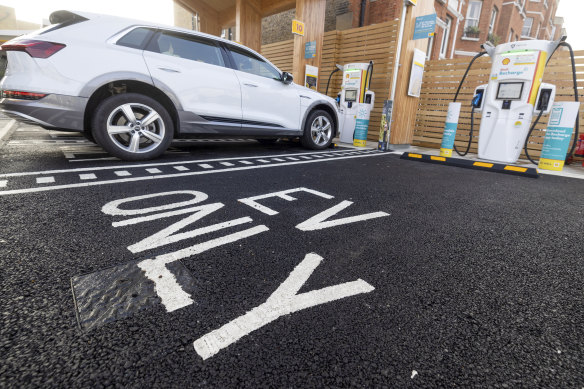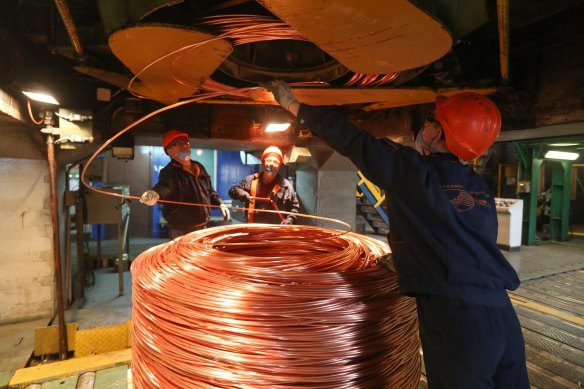
Under its base case – average global warming of between 2.2 degrees celsius and 2.4 degrees by mid-century, there would be a 6.5 million tonne shortfall in supply.
To meet accelerated zero-carbon targets (limiting the rise in temperatures to 1.5 degrees) Wood Mackenzie says 9.7 million tonnes of mine supply would be needed over the next decade from projects that have yet to be sanctioned; an increase in supply never previously achieved.
Low-carbon copper demand over the next 20 years, it said, would be equivalent to more than 60 per cent of the current size of the copper market and the extra production required from new projects for emissions-reducing technologies would be equivalent to nearly a third of current refined copper consumption.

The increasing popularity of electric cars is ramping up demand for copper.Credit:Bloomberg
That would require about $US23 billion ($36.1 billion) of investment a year in new projects, or 64 per cent more than the average annual spend over the past 30 years and would underpin a rise in the copper price to more than $US11,000 a tonne within five years, the consultancy said. The copper price today is about $US7500 a tonne.
The prospect of those sorts of price rises would normally induce increased supply and the scramble to do so is already on, with a particular but not exclusive focus on exploration in South America.
Rising capital and operating costs for new copper projects, the scarcity of new world-class deposits, the time and cost it takes to approve new projects in developed economies and the political and economic risks of developing new mines in developing economies, however, make an increase in supply of the magnitude Wood Mackenzie believes will be required challenging, to say the least.
Declining grades and rising costs in existing large-scale mines exacerbate the size of that challenge, as do increasing environmental obstacles, costs and delays for new mines or expansions of existing projects.
In the resource sector, timing is everything because the sector, and commodity prices, are so volatile and cyclical and the capital costs so substantial.
Wood Mackenzie says electric vehicles will be by far the largest single contributor to increased copper demand – about 55 per cent of it – with EVs using more than three times the copper as internal combustion vehicles. It said demand for copper from the EV segment will grow by 9.6 million tonnes over the next 20 years.
To that would be added the usage of copper in the continuing expansion of the renewable energy technologies and, of course, growth in the existing non-climate related demand.
Loading
The disconnect between the current and near-term outlook for the metal, where the gloomy economic settings weigh heavily on the metal arguably the most sensitive to economic conditions, and what forecasters are saying about the supply needed to meet carbon emissions reduction targets is a challenge for a resources sector that has been burned in the past by assuming that prices in supply-constrained commodities can only trend up.
After the end of the last China-inspired commodity boom last decade, the new-found financial disciplines of the miners has contributed to the relative dearth of new large-scale copper projects, along with the paucity of world-class new projects.
It is the prospect of the copper shortage, for instance, that attracted BHP to Oz Minerals earlier this year. It’s probably the unwillingness to overcapitalise that prospect in a volatile environment that caused Mike Henry to describe Oz Minerals as a “nice to have” rather than a “must have” and why Oz Minerals, which flatly rejected BHP’s offer, and BHP appear far apart in perceptions of value.
If the Wood Mackenzies and S&P Globals are proven right – in a decade or two’s time – a failure to acquire Oz Minerals would look like a missed opportunity for BHP, albeit not a company-reshaping one. On the other hand, Oz Minerals shareholders may not want to wait a decade, or two, to realise the potential latent value of their resources.
In the resource sector, timing is everything because the sector, and commodity prices, are so volatile and cyclical and the capital costs so substantial. All the miners will be trying to finesse their exposures to copper’s potential and reduce their risks by gaining that exposure as cheaply as possible – or by paying somewhat more if the risks are reduced by actual, rather than hypothetical, demand levels.

Russia is reponsible for about five per cent of the world’s copper supply. The war in Ukraine has put a big question mark on future production.Credit:Bloomberg
That caution, given the sector’s not-so-distant-past, is understandable. If the forecasters are right, however, and there is an acceleration towards a zero-carbon future, it will exacerbate the extent of the supply shortfalls and their impact on copper prices.
The current tightness of the copper market might be alleviated to some degree as projects in the existing pipeline (factored into the Wood Mackenzie and S&P analyses) enter the market.
Loading
If, as they project, however, demand doubles in just over a decade and then keeps growing, the supply-demand equation will become insoluble – and the net-zero target impossible to achieve – unless the amount of new supply entering the market within the next few years is increased urgently and dramatically.
The Business Briefing newsletter delivers major stories, exclusive coverage and expert opinion. Sign up to get it every weekday morning.









 Add Category
Add Category